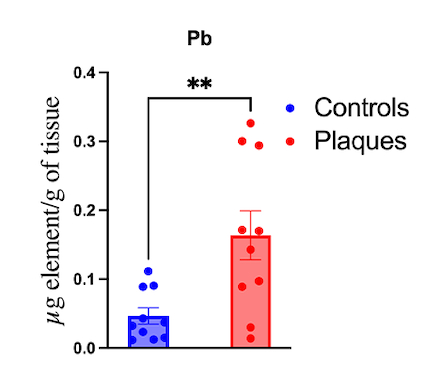Final ID: We0066
Carotid Atherosclerotic Plaque Heavy Metals are Associated with Clinical Symptoms
Abstract Body: Introduction: Carotid artery atherosclerosis has been associated with high levels of non-essential transition metals such as iron, chromium and platinum. This observation has been suggested to be a missing link in atherogenesis but connecting plaque metal composition to clinical symptom status and mechanistic atherosclerotic pathways has yet to be investigated. Plaque levels of toxic heavy metals lead (Pb) and cobalt (Co) have not been fully described. Concentrations of essential metals with a role in anti-oxidation, endothelial function and modulation of inflammation such as molybdenum (Mo) have not been investigated.
Hypothesis: We tested the hypothesis that carotid plaque metal content would be associated with carotid stenosis and clinical symptomatic status.
Methods: Whole carotid plaques were collected during carotid endarterectomy for carotid stenosis and flash frozen. Symptomatic subjects had stroke, TIA or amaurosis fugax. Age-matched control non-atherosclerotic carotid arteries were obtained from fresh cadaveric donors. Quantitative metals concentrations were determined by inductively coupled plasma mass spectrometry (ICP-MS).
Results: A total of 20 carotid samples were analyzed. Atherosclerotic plaques were mostly male (90%) with mean age 70 years. Plaques were symptomatic in 40% of cases. Carotid plaques demonstrated higher levels of Na (4909 vs. 3667 µg/g), Mg (643 vs. 22 µg/g), K (325 vs. 10 µg/g), Ca (40,539 vs. 921 µg/g), Co (0.02 vs. 0.001 µg/g), Zn (58 vs. 12 µg/g, all P<0.05). Selenium (Se) levels correlated with carotid symptom status as asymptomatic plaques contained 2.2 fold and symptomatic contained 3.6 fold more Se compared to control (P<0.001). Pb levels in symptomatic plaques were 5-fold greater than control vessels (P=0.01) but did not differ from asymptomatic plaques. Copper (Cu) levels were 3.2 fold greater in symptomatic plaques (P=02). Mo levels demonstrated a 2.6 fold decrease in plaques compared to control arteries (P=0.03).
Conclusion: Carotid atherosclerotic plaques contain significantly higher concentrations of a variety of transition and toxic heavy metals and metalloids (Se) compared to control non-atherosclerotic arteries. Elevated plaque Cu and Se are associated with carotid symptoms and may be influencing plaque stability through unknown mechanisms. Mo deficiency in carotid plaques may be associated with impairments in known anti-oxidant and anti-inflammatory functions and should be investigated further.
Hypothesis: We tested the hypothesis that carotid plaque metal content would be associated with carotid stenosis and clinical symptomatic status.
Methods: Whole carotid plaques were collected during carotid endarterectomy for carotid stenosis and flash frozen. Symptomatic subjects had stroke, TIA or amaurosis fugax. Age-matched control non-atherosclerotic carotid arteries were obtained from fresh cadaveric donors. Quantitative metals concentrations were determined by inductively coupled plasma mass spectrometry (ICP-MS).
Results: A total of 20 carotid samples were analyzed. Atherosclerotic plaques were mostly male (90%) with mean age 70 years. Plaques were symptomatic in 40% of cases. Carotid plaques demonstrated higher levels of Na (4909 vs. 3667 µg/g), Mg (643 vs. 22 µg/g), K (325 vs. 10 µg/g), Ca (40,539 vs. 921 µg/g), Co (0.02 vs. 0.001 µg/g), Zn (58 vs. 12 µg/g, all P<0.05). Selenium (Se) levels correlated with carotid symptom status as asymptomatic plaques contained 2.2 fold and symptomatic contained 3.6 fold more Se compared to control (P<0.001). Pb levels in symptomatic plaques were 5-fold greater than control vessels (P=0.01) but did not differ from asymptomatic plaques. Copper (Cu) levels were 3.2 fold greater in symptomatic plaques (P=02). Mo levels demonstrated a 2.6 fold decrease in plaques compared to control arteries (P=0.03).
Conclusion: Carotid atherosclerotic plaques contain significantly higher concentrations of a variety of transition and toxic heavy metals and metalloids (Se) compared to control non-atherosclerotic arteries. Elevated plaque Cu and Se are associated with carotid symptoms and may be influencing plaque stability through unknown mechanisms. Mo deficiency in carotid plaques may be associated with impairments in known anti-oxidant and anti-inflammatory functions and should be investigated further.
More abstracts on this topic:
Association between Neurological Complications and Carotid-cerebral Artery Disease after Coronary Artery Bypass Grafting
Liu Yi, Zhu Yunpeng, Jin Wei, Jin Zhijia, Gu Jianwei, Zhao Qiang
Comparative Assessment of hsCRP and Apolipoprotein B as ASCVD Risk BiomarkersAmusat Saheed Oladele



